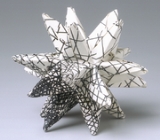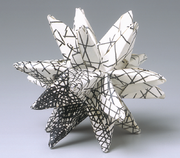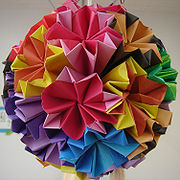
Modular origami
Encyclopedia

Origami
is the traditional Japanese art of paper folding, which started in the 17th century AD at the latest and was popularized outside Japan in the mid-1900s. It has since then evolved into a modern art form...
technique which uses multiple sheets of paper
Paper
Paper is a thin material mainly used for writing upon, printing upon, drawing or for packaging. It is produced by pressing together moist fibers, typically cellulose pulp derived from wood, rags or grasses, and drying them into flexible sheets....
to create a larger and more complex structure than would be possible using single-piece origami
Origami
is the traditional Japanese art of paper folding, which started in the 17th century AD at the latest and was popularized outside Japan in the mid-1900s. It has since then evolved into a modern art form...
techniques. Each individual sheet of paper is folded into a module, or unit, and then modules are assembled into an integrated flat shape or three-dimensional structure by inserting flaps into pockets created by the folding process. These insertions create tension or friction that holds the model together.
Definition and restrictions

Glue
This is a list of various types of glue. Historically, the term "glue" only referred to protein colloids prepared from animal flesh. The meaning has been extended to refer to any fluid adhesive....
, thread
Yarn
Yarn is a long continuous length of interlocked fibres, suitable for use in the production of textiles, sewing, crocheting, knitting, weaving, embroidery and ropemaking. Thread is a type of yarn intended for sewing by hand or machine. Modern manufactured sewing threads may be finished with wax or...
, or any other fastening that is not a part of the sheet of paper is not generally acceptable in modular origami.
The additional restrictions that distinguish modular origami from other forms of multi-piece origami are using many identical copies of any folded unit, and linking them together in a symmetrical or repeating fashion to complete the model. There is a common misconception that treats all multi-piece origami as modular, but this is not the case.
More than one type of module can still be used. Typically this means using separate linking units hidden from sight to hold parts of the construction together. Any other usage is generally frowned upon.
The word origami comes from Japan. "Oru" meaning to fold and "Kami" meaning paper
History

Cube
In geometry, a cube is a three-dimensional solid object bounded by six square faces, facets or sides, with three meeting at each vertex. The cube can also be called a regular hexahedron and is one of the five Platonic solids. It is a special kind of square prism, of rectangular parallelepiped and...
. The cube is pictured twice (from slightly different angles) and is identified in the accompanying text as a tamatebako
Tamatebako
The is an Origami model featured in a Japanese folk tale. It is a modular cube design that can be opened from any side. If more than one face of the model is opened, the cube falls apart and cannot easily be reconstructed...
, or a 'magic treasure chest'.
Isao Honda's World of Origami (Japan Publications ISBN 0-87040-383-4 published in 1965) appears to have the same model, where it is called the 'Cubical Box'. The six modules required for this design were developed from the traditional Japanese paperfold commonly known as the Menko. Each module forms one face of the finished cube.
There are several other traditional Japanese modular origami designs, including balls of folded paper flowers known as kusudama
Kusudama
The Japanese kusudama is a paper model that is usually created by sewing multiple identical pyramidal units together through their points to form a spherical shape. Alternately the individual components may be glued together. The Japanese kusudama (薬玉; lit. medicine ball) is a paper model that...
, or medicine balls. These designs are not integrated and are commonly strung together with thread. The term kusudama is sometimes, rather inaccurately, used to describe any three-dimensional modular origami structure resembling a ball.
There are also a few modular designs in the Chinese paperfolding tradition, notably the Pagoda (from Maying Soong) and the Lotus made from Joss paper
Joss paper
Joss paper , also known as ghost money, are sheets of paper and/or paper-crafts made into burnt offerings which are common in traditional Chinese religious practices including the veneration of the deceased on holidays and special occasions...
.
Most traditional designs are however single-piece and the possibilities inherent in the modular origami idea were not explored further until the 1960s when the technique was re-invented by Robert Neale
Robert Neale (paperfolder)
Robert E. Neale is a preeminent American paperfolder and magician, who has written several books on the combination of the two. Among them are:* Folding Money Fooling* Frog Tales...
in the USA and later by Mitsonobu Sonobe in Japan. Since then the modular origami technique has been popularized and developed extensively, and now there have been thousands of designs developed in this repertoire.
Types of modular origami
Modular origami forms may be flat or three-dimensional. Flat forms are usually polygonPolygon
In geometry a polygon is a flat shape consisting of straight lines that are joined to form a closed chain orcircuit.A polygon is traditionally a plane figure that is bounded by a closed path, composed of a finite sequence of straight line segments...
s (sometimes known as coasters), stars, rotors, and rings. Three-dimensional forms tend to be regular polyhedra
Polyhedron
In elementary geometry a polyhedron is a geometric solid in three dimensions with flat faces and straight edges...
or tessellations of simple polyhedra.
There are some modular origami that are approximations of fractals, such as Menger's sponge.
Macro-modular origami is a form of modular origami in which finished assemblies are themselves used as the building blocks to create larger integrated structures. Such structures are described in Tomoko Fuse
Tomoko Fusé
Tomoko Fuse is a Japanese origami writer and artist who has written many books on the subject of modular origami and is by many considered to be the master of unit origami and one of the pre-eminent living Japanese Origami Masters.She has designed many modular boxes and containers, kusudama, paper...
's book Unit Origami-Multidimensional Transformations (Japan Publications ISBN 0-87040-852-6 published in 1990)
Notable modular paperfolders
- Robert NealeRobert Neale (paperfolder)Robert E. Neale is a preeminent American paperfolder and magician, who has written several books on the combination of the two. Among them are:* Folding Money Fooling* Frog Tales...
- Mitsonobu Sonobe
- Tomoko FuseTomoko FuséTomoko Fuse is a Japanese origami writer and artist who has written many books on the subject of modular origami and is by many considered to be the master of unit origami and one of the pre-eminent living Japanese Origami Masters.She has designed many modular boxes and containers, kusudama, paper...
- Kunihiko KasaharaKunihiko Kasaharais a Japanese origami master. He has made hundreds of models, from simple lion masks to complex modular origami, such as a small stellated dodecahedron. He does not specialize in what is known as "super complex origami", but rather he likes making simple, elegant animals, and modular designs such...
- Francis Ow
- Tom HullTom HullTom Hull is an associate professor of mathematics at Western New England University and is known for his expertise in the mathematics of paper folding.Prior to his appointment at Western New England, Hull taught at Merrimack College...
- Meenakshi Mukerji
- Heinz Strobl
- Miyuki Kawamura
- Rona Gurkewitz
- Bennett Arnstein
- Valerie Vann
- David Mitchell
Robert Neale's Penultimate Module
Robert Neale developed a system to model equilateral polyhedraEquilateral
In geometry, an equilateral polygon is a polygon which has all sides of the same length.For instance, an equilateral triangle is a triangle of equal edge lengths...
based on a module with variable vertex
Vertex (geometry)
In geometry, a vertex is a special kind of point that describes the corners or intersections of geometric shapes.-Of an angle:...
angles. Each module has two pockets and two tabs, on opposite sides. The angle of each tab can be changed independently of the other tab. Each pocket can receive tabs of any angle. The most common angles form polygonal faces:
- 60 degrees (triangleTriangleA triangle is one of the basic shapes of geometry: a polygon with three corners or vertices and three sides or edges which are line segments. A triangle with vertices A, B, and C is denoted ....
) - 90 degrees (squareSquare (geometry)In geometry, a square is a regular quadrilateral. This means that it has four equal sides and four equal angles...
) - 108 degrees (pentagonPentagonIn geometry, a pentagon is any five-sided polygon. A pentagon may be simple or self-intersecting. The sum of the internal angles in a simple pentagon is 540°. A pentagram is an example of a self-intersecting pentagon.- Regular pentagons :In a regular pentagon, all sides are equal in length and...
) - 120 degrees (hexagon)
Each module joins others at the vertices of a polyhedron
Polyhedron
In elementary geometry a polyhedron is a geometric solid in three dimensions with flat faces and straight edges...
to form a polygon
Polygon
In geometry a polygon is a flat shape consisting of straight lines that are joined to form a closed chain orcircuit.A polygon is traditionally a plane figure that is bounded by a closed path, composed of a finite sequence of straight line segments...
al face. the tabs form angles on opposite sides of an edge. For example, a subassembly of three triangle corners forms a triangle, the most stable configuration. As the internal angle increases for squares, penatagons and so forth, the stability decreases.
Many polyhedra call for unalike adjacent polygons. for example, a pyramid
Pyramid (geometry)
In geometry, a pyramid is a polyhedron formed by connecting a polygonal base and a point, called the apex. Each base edge and apex form a triangle. It is a conic solid with polygonal base....
has one square face and three triangular faces. This requires hybrid modules, or modules having different angles. A pyramid consists of eight modules, four modules as square-triangle, and four as triangle-triangle.
Further polygonal faces are possible by altering the angle at each corner. The Neale modules can form any equilateral polyhedron including those having rhombic
Rhombus
In Euclidean geometry, a rhombus or rhomb is a convex quadrilateral whose four sides all have the same length. The rhombus is often called a diamond, after the diamonds suit in playing cards, or a lozenge, though the latter sometimes refers specifically to a rhombus with a 45° angle.Every...
faces, like the rhombic dodecahedron
Rhombic dodecahedron
In geometry, the rhombic dodecahedron is a convex polyhedron with 12 rhombic faces. It is an Archimedean dual solid, or a Catalan solid. Its dual is the cuboctahedron.-Properties:...
.
Mukhopadhyay module
The Mukhopadhyay module can form any equilateral polyhedron. Each unit has a middle crease that forms an edge, and triangular wings that form adjacent stellated faces. For example, a cuboctahedral assembly has 24 units, since the cuboctahedronCuboctahedron
In geometry, a cuboctahedron is a polyhedron with eight triangular faces and six square faces. A cuboctahedron has 12 identical vertices, with two triangles and two squares meeting at each, and 24 identical edges, each separating a triangle from a square. As such it is a quasiregular polyhedron,...
has 24 edges.
Additionally, bipyramids are possible, by folding the central crease on each module outwards or convexly instead of inwards or concavely as for the icosahedron
Icosahedron
In geometry, an icosahedron is a regular polyhedron with 20 identical equilateral triangular faces, 30 edges and 12 vertices. It is one of the five Platonic solids....
and other stellated polyhedra. The Mukhopadhyay module works best when glued together, especially for polyhedra having larger numbers of sides.
External links
- 3dOrigamiArt.com Learn how to 3d Origami, tutorials and artist network.
- OrigamiTube.com Watch, fold, and show off your modular masterpiece.
- Star Kusudama Instructions
- Kusudama Pictures
- Photo Gallery and Folding Instructions For Many Polyhedra and Variations
- Some Artistic Examples
- Image of Menger's Sponge in origami
- Origami tetrahedron page
- Origami Geosphere Paper model of a Geodesic Sphere.
- Mukhopadhyay's super simple isosceles triangle module
- James S. Plank's Penultimate Modular Origami
- Mitsonobu Sonobe's Module
- PHiZZ unit
- Oxi Module by Michał Kosmulski
- Kusudama Me! Kusudamas of Lukasheva Ekaterina, also diagrams and tutorials

